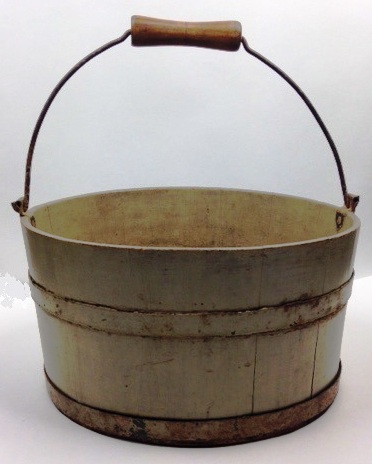
Pail, Church Family, Canterbury, NH, ca. 1850, Shaker Museum | Mount Lebanon, 1956.8084.
At first glance this simple Shaker pail, or bucket if you prefer, seems straightforward in its intended use – it’s a pail – it holds water, or whatever else is put in it. Upon careful examination, however, a story emerges. Made by the Shakers at Canterbury, New Hampshire, it bears characteristics of pails made in that […]
At first glance this simple Shaker pail, or bucket if you prefer, seems straightforward in its intended use – it’s a pail – it holds water, or whatever else is put in it. Upon careful examination, however, a story emerges.

Pail, Church Family, Canterbury, NH, ca. 1850, Shaker Museum | Mount Lebanon, 1956.8084.
Made by the Shakers at Canterbury, New Hampshire, it bears characteristics of pails made in that community. Canterbury coopers used a V-shaped tongue-and-groove to join the staves of their pails together – a feature not seen in pails made elsewhere, but present in this pail. The iron hoops terminate in a typical Canterbury V-shape. The bail plates that hold the wire handle are of an uncommon, but not unknown, shape for Canterbury pails and the pail has the initials “F.W.” stamped into its bottom. These initials, the initials of Francis Winkley, were used to mark Shaker products offered for sale such as spinning wheels, cooper-ware, and garden seeds. Winkley was a deacon at the Church Family at Canterbury and, as such, was responsible for the sale of Shaker products.

Pail, Church Family, Canterbury, NH, ca. 1850, Shaker Museum | Mount Lebanon, 1956.8084.
The uniqueness of this pail begins to show itself when measured. The pail is only 6 inches high to the rim and is 12 3/4 inches in diameter in the direction the handle is mounted and 11 5/8 inches in the other direction, measured at the top of the rim. This mere 1 1/8 inch difference makes the pail oval rather than round. All other known Shaker pails are round. The answer to why this pail was constructed in an oval shape lies buried beneath a thick layer of old gray-green paint. Using a raking light with the bottom of the pail held at just the right angle, the word “Foot” can be read beneath the paint and just above that, the letters “SY.” At the Canterbury Church Family, the abbreviation “SY” was used to identify objects that belonged in the Infirmary. So, at one time this pail was likely used in the Infirmary for foot baths. With 10 1/2 inches at the bottom of the pail, a man with a size 10 shoe could fit his foot into the pail comfortably – a woman with a size 11 shoe could do the same. For Shaker brothers or sisters with larger feet, there were always wash tubs.

Pail (detail of V-groove stave joint), Church Family, Canterbury, NH, ca. 1850, Shaker Museum | Mount Lebanon, 1956.8084.

Pail (detail of markings on bottom ), Church Family, Canterbury, NH, ca. 1850, Shaker Museum | Mount Lebanon, 1956.8084.
One curious thing about this pail is why it was stamped with Francis Winkley’s initials at all. Usually, products that were intended for sale were marked – not objects intended for home use. Winkley was not the make – only the purveyor. Perhaps someday the explanation will come to light.